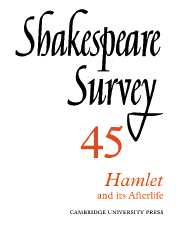Book contents
- Frontmatter
- The Reception of Hamlet
- ‘Hamlet, Revenge!’: The Uses and Abuses of Historical Criticism
- Revision by Excision: Rewriting Gertrude
- Gazing at Hamlet, or the Danish Cabaret
- ‘He’s Going to his Mother’s Closet’: Hamlet and Gertrude on Screen
- Shakespeare Rewound
- Freud’s Hamlet
- ‘Pray you, undo this button’: Implications of ‘Un-’ in King Lear
- Marx and Shakespeare
- Peter Street, 1553–1609: Builder of Playhouses
- Shakespeare Performances in England 1990–1
- Professional Shakespeare Productions in the British Isles, January–December 1990
- 1 Critical Studies
- 2 Shakespeare’s Life, Times, and Stage
- 3 Editions and Textual Studies
- Books Received
- Index
‘Pray you, undo this button’: Implications of ‘Un-’ in King Lear
Published online by Cambridge University Press: 28 March 2007
- Frontmatter
- The Reception of Hamlet
- ‘Hamlet, Revenge!’: The Uses and Abuses of Historical Criticism
- Revision by Excision: Rewriting Gertrude
- Gazing at Hamlet, or the Danish Cabaret
- ‘He’s Going to his Mother’s Closet’: Hamlet and Gertrude on Screen
- Shakespeare Rewound
- Freud’s Hamlet
- ‘Pray you, undo this button’: Implications of ‘Un-’ in King Lear
- Marx and Shakespeare
- Peter Street, 1553–1609: Builder of Playhouses
- Shakespeare Performances in England 1990–1
- Professional Shakespeare Productions in the British Isles, January–December 1990
- 1 Critical Studies
- 2 Shakespeare’s Life, Times, and Stage
- 3 Editions and Textual Studies
- Books Received
- Index
Summary
Perhaps no final scene of a play has had more attention than the end of King Lear. Regardless of how any one critic interprets the play, an important element of that interpretation involves a response to the action from Lear’s entrance with Cordelia in his arms to his death. And, however this scene is integrated into or used as justification for an overall interpretation, there is usually an acknowledgement of its inherent ambiguity: that we cannot be certain how to respond to these concentrated, intense moments. This has prompted everything from unqualified optimism to unrelieved pessimism - responses probably revealing more about the spectator or critic than the play. But the most perceptive attempts to understand the play allow for both joy and sorrow at its conclusion, a response signalled several times during the action. As essentially tragic as the ending is, there also is, or should be, a sense of rightness about it that cannot be ignored in production and interpretation without lessening the impact by reducing the relationship between the conclusion and what has gone before. That things have come full circle is an idea voiced towards the end of the play. We are prompted to become aware of its complexity not so much by the rationalizing observations of Edgar and Edmund or the optimistic commentary of Albany and Kent as by signals in the language and action immediately before Lear's death suggesting a renewal of his essential roles of king and father for a few brief but significant moments. In this play built on visual and verbal paradoxes, in which appearance and speech obscure deeper truths, it should not be surprising that what is done and said at the protagonist's end contains and completes this motif.
- Type
- Chapter
- Information
- Shakespeare Survey , pp. 79 - 88Publisher: Cambridge University PressPrint publication year: 1992



